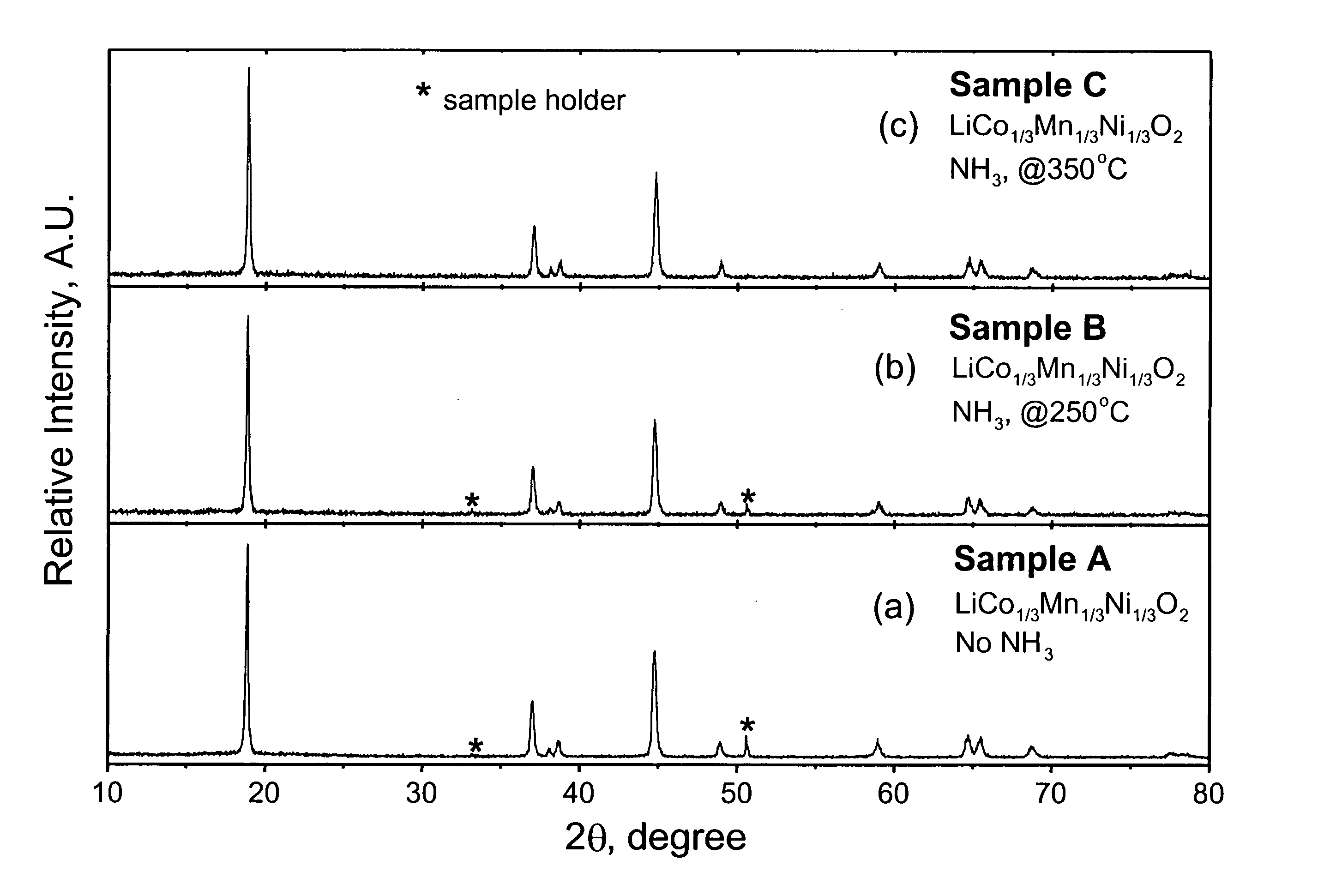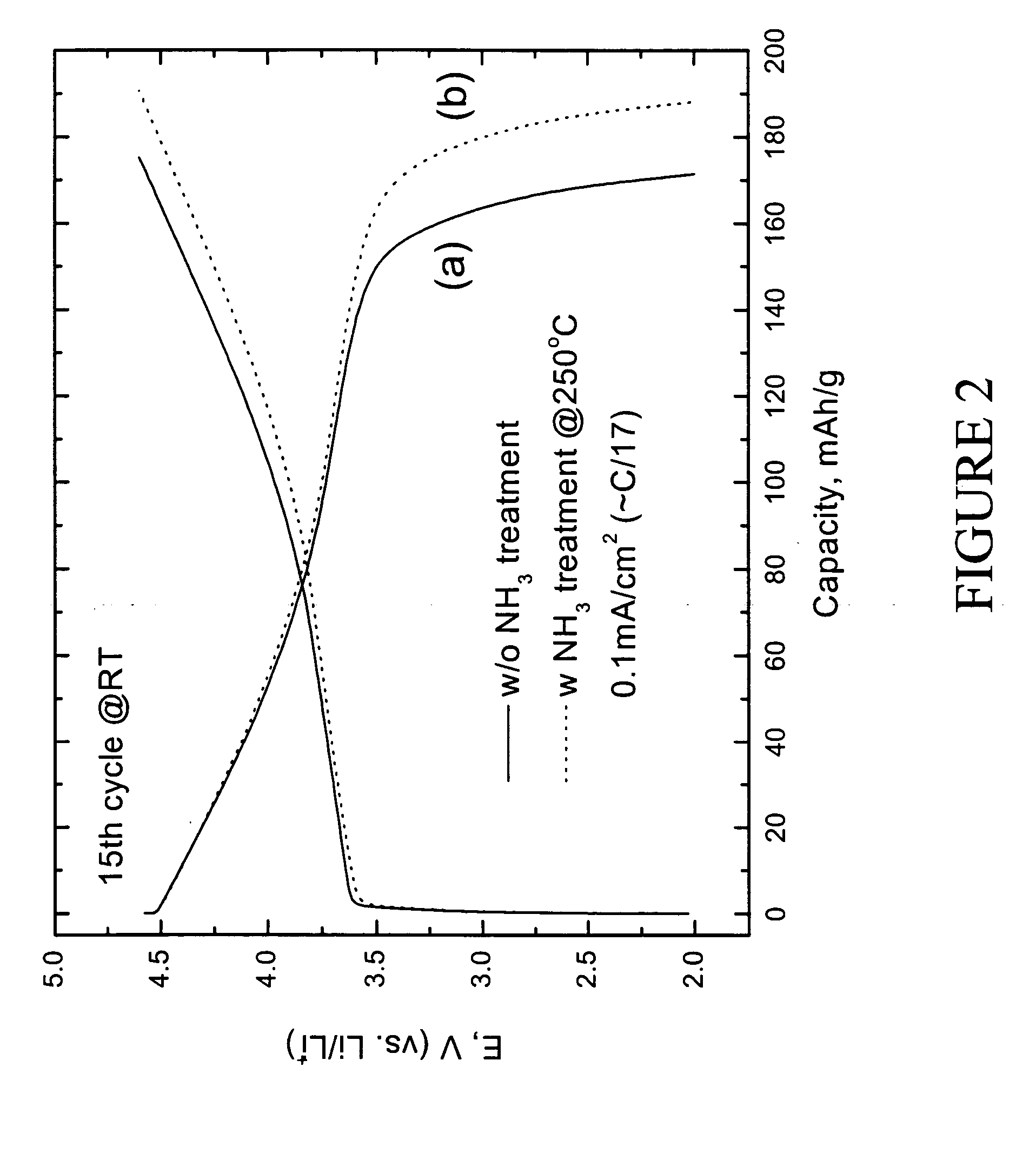Lithium metal oxide electrodes for lithium batteries
a lithium battery and metal oxide technology, applied in the direction of nickel compounds, manganates/permanentates, cell components, etc., can solve the problems of low lithium content, unstable lithium cathode, high cost, etc., and achieve the effect of improving capacity, cycling efficiency and cycling stability
- Summary
- Abstract
- Description
- Claims
- Application Information
AI Technical Summary
Benefits of technology
Problems solved by technology
Method used
Image
Examples
example 1
Synthesis of LiMn0.33Ni0.33Co0.33O2 Electrodes
LiMn0.33Ni0.33Co0.33O2 powder was synthesized from LiOH•H2O and Mn0.33Ni0.33Co0.33(OH)x (x˜2) precursors. LiOH•H2O was used as supplied by Aldrich (98% pure). The Mn0.33Ni0.33Co0.33(OH)x precursor was prepared by coprecipitation of the required stiochiometric amounts of metal nitrates M(NO3)2•xH2O (M=Mn, Ni, and Co). After intimate mixing and grinding, the powdered mixture was pressed into a pellet and placed in a muffle furnace. A two-step heating procedure was used to fire the pellet according to the following procedure. First, a low temperature calcination step was performed at 480° C. for 5 hr. The pellet was then ground again and recompacted into pellet form. Second, a high temperature sintering step was performed at 900° C. for 3 hr followed by rapid quenching of the pellet between two copper plates. The pellet was ground a final time. Samples of the resulting LiMn0.33Ni0.33Co0.33O2 powder were heated at either 250 or 350° C. for...
example 2
Electrochemical Evaluation of LiMn0.33Ni0.33Co0.33O2 Electrodes
Electrochemical evaluation of LiMn0.33Ni0.33Co0.33O2 and preconditioned LiMn0.33Ni0.33Co0.33O2 positive electrodes was carried out as follows. The electrodes for the lithium cell were fabricated from an intimate mixture of 84 wt % of LiMn0.33Ni0.33Co0.33O2 electrode powder, 8 wt % polyvinylidene difluoride (PVDF) polymer binder (Kynar, Elf-Atochem), 4 wt % acetylene black (Cabot), and 4 wt % graphite (SFG-6, Timcal) slurried in 1-methyl-2-pyrrolidinone (NMP) (Aldrich, 99+%). An electrode laminate was cast from the slurry onto an Al current collector foil using a doctor-blade. The laminate was subsequently dried, first at 75° C. for 10 h, and thereafter under vacuum at 70° C. for 12 h. The electrolyte was 1M LiPF6 in ethylene carbonate (EC):diethyl carbonate (DEC) (1:1 mixture). The electrodes were evaluated at both room temperature and 50° C. in coin-type cells (size CR2032, Hohsen) with a lithium foil counter electrod...
example 3
Synthesis of 0.3Li2MnO3•0.7LiMn0.5Ni0.5O2 Composite Electrodes
An electrode material with the composite formula 0.3Li2MnO3•0.7LiMn0.5Ni0.5O2 was prepared directly from Ni1-xMnx(OH)2 and LiOH•H2O precursors using the required Li:Mn:Ni ratio. The Ni1-xMnx(OH)2 precursor was prepared by precipitation from a basic LiOH solution of Ni(NO3)2 and Mn(NO3)2 (pH ˜11). The reagents were intimately mixed in an acetone slurry, dried in an oven overnight, and subsequently fired at 480° C. for 12 h and then at 900° C. for 5 h in air. Thereafter, the 0.3Li2MnO3•0.7LiMn0.5Ni0.5O2 product was rapidly quenched (also in air). The X-ray diffraction pattern of the resulting powder is shown in FIG. 8a (Sample D). The electrode powder was preconditioned according to the following procedures prior to cell assembly: 1) subjecting the powder to flowing NH3 gas in a tubular furnace at 200° C. for approximately 20 hrs, the X-ray diffraction pattern of this product being shown in FIG. 8b (Sample E); 2) washing ...
PUM
| Property | Measurement | Unit |
|---|---|---|
| Temperature | aaaaa | aaaaa |
| Temperature | aaaaa | aaaaa |
| Temperature | aaaaa | aaaaa |
Abstract
Description
Claims
Application Information
 Login to View More
Login to View More - R&D
- Intellectual Property
- Life Sciences
- Materials
- Tech Scout
- Unparalleled Data Quality
- Higher Quality Content
- 60% Fewer Hallucinations
Browse by: Latest US Patents, China's latest patents, Technical Efficacy Thesaurus, Application Domain, Technology Topic, Popular Technical Reports.
© 2025 PatSnap. All rights reserved.Legal|Privacy policy|Modern Slavery Act Transparency Statement|Sitemap|About US| Contact US: help@patsnap.com



